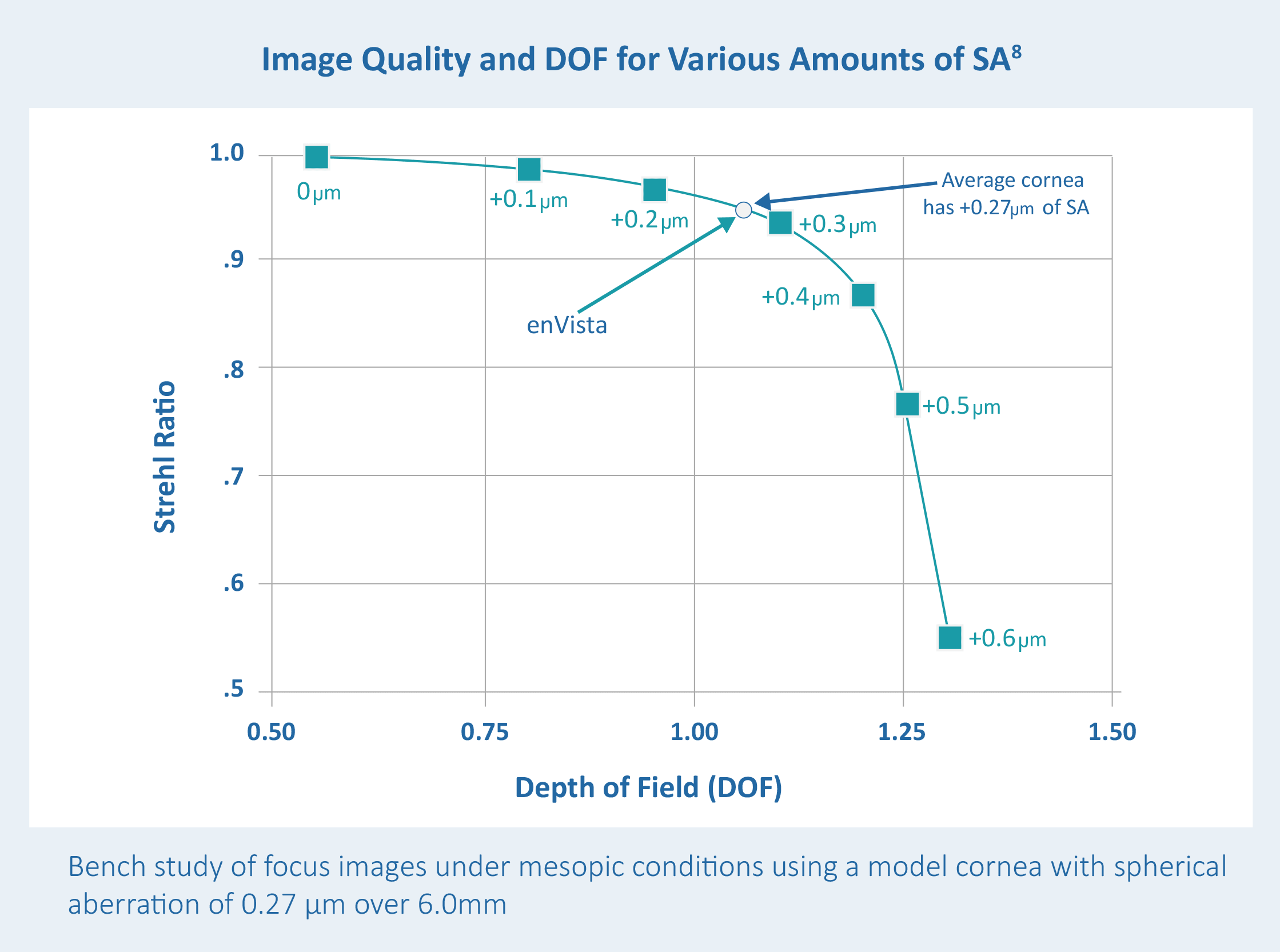enVista® IOLs Provide Clear Outcomes for Surgeons and Patients
Dr. William Wiley is a board-certified ophthalmologist and the medical director of the Cleveland Eye Clinic in Northeast Ohio. He has firsthand experience with the enVista intraocular lens (IOL) platform and noted that “enVista is very stable, produces impressive visual acuity, and offers high rates of patient satisfaction” among his patient population.
enVista is aberration free with uniform power throughout the lens
enVista is an advanced aberration-free hydrophobic acrylic IOL that provides a balance between depth of field and image quality.1 enVista has uniform power center to edge. Because enVista has uniform power throughout the lens, it is able to compensate for common levels of decentration and tilt.2,3,4,5,6,7
enVista can be used in various patient types
The enVista toric IOL is also particularly adapted for patients with decentered pupils where lens centration is a risk. enVista has a unique optical design which allows consistent power from center to edge of the optic, consequently offering a great tolerance to decentration. enVista is also a solid option for irregular cornea or unknown spherical aberration (SA).
In some patients with higher levels of negative SA, implanting a lens with additional negative SA can further detract from achieving best corrected visual acuity. Dr. Wiley prefers a lens, such as enVista, which is spherically neutral and less sensitive to these patient conditions.
enVista toric lenses are an important option in patients with astigmatism
The enVista toric IOL is a great option for patients with astigmatism. Because of the incidence in the population/occurrence curves, most patients Dr. Wiley sees with astigmatism have a low diopter range with about a diopter of astigmatism.

Figure 1.
“What makes enVista unique is the power ranges. enVista toric has the ability to go slightly lower for the toric power range.” Dr. Wiley appreciates how enVista toric enables him to treat more patients with lens-based astigmatism correction. In his opinion, treating astigmatism with an IOL is preferable to treating it on the cornea. Using an IOL is stable and predictable, and enVista has the current lowest diopter power on the market in the U.S.9
Dr. Wiley noted that many patients who have had hyperopic Lasik surgery have a high degree of negative SA, and an SA-neutral toric lens would be his preferred option for cataract surgery when astigmatism correction is needed. Dr. Wiley prefers the enVista toric lens in patients "with post-hyperopic Lasik when the eye has a lot of negative spherical aberration, because enVista toric is not additive to the negative spherical aberration.” In post-op Lasik patients where a negative SA lens is used, “patients are often dissatisfied with quality of vision following cataract surgery” in Dr. Wiley’s experience. “A neutral SA lens allows the surgeon to take advantage of the corneal depth of focus and not alter it. That is a nice advantage to the enVista toric lens,” according to Dr. Wiley.
Unique design balances depth of field and image quality

Figure 2. Shown here is the relationship between Image Quality and Depth of Field provided by an average natural cornea alongside the Image Quality and Depth of Field provided by the aberration-free optic profile of enVista MX60. The Strehl ratio indicates the level of image quality in the presence of wavefront aberrations.
enVista delivers predictable outcomes
enVista provides patients with excellent contrast sensitivity and outstanding visual quality following cataract surgery.2,3 In a laboratory study using an ISO-1 cornea, the residual aberrations are higher with AcrySof® IQ and TECNIS® IOLs than with enVista. The enVista aberration-free optic delivers increased light throughout compared to AcrySof IQ and TECNIS lenses and predictably provides exceptional image quality and contrast sensitivity regardless of pupil size.3
enVista is glistening free
enVista has proven, glistening-free performance.2 Dr. Wiley is confident that glistenings will not develop over time in patients where he uses enVista lenses. He has several patients in his practice that received lenses about 20 years ago who are referred in from optometrists noticing that the lens looks cloudy and asking for an intervention. The proven glistening-free enVista platform is especially important to consider for younger patients who could have the lens for many years.
enVista with SimplifEYE is easy to use
The SimplifEYE IOL delivery system makes it very easy to insert an enVista lens. This allows Dr. Wiley to confirm the placement of enVista and measure the lens with intraoperative aberrometry while he is still in the operating room.


William F. Wiley, MD is a board-certified ophthalmologist who has pioneered many eye procedures in the Northeast Ohio area. He is the medical director of the Cleveland Eye Clinic and is an Assistant Clinical Professor of Ophthalmology at the University Hospitals/Case Western Reserve University. Dr. Wiley has performed more than 50,000 cataract and refractive surgical procedures.
Financial Disclosure: Consultant to Bausch + Lomb